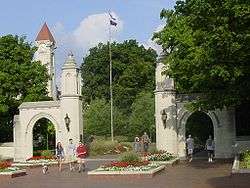Eskenazi Museum of Art
The Eskenazi Museum of Art at Indiana University opened in 1941 under the direction of Henry Radford Hope.[1] The museum was intended to be the center of a “cultural crossroads,” an idea brought forth by then-Indiana University President Herman B Wells.[1] The present museum building was designed by I.M. Pei and Partners and dedicated in 1982.[1] The museum's collection comprises approximately 45,000 objects, with about 1,400 on display.[2] The collection includes items ranging from ancient jewelry and paintings by Pablo Picasso and Jackson Pollock. In May 2016, after the announcement of the largest cash gift in the museum's history, the museum was renamed the Sidney and Lois Eskenazi Museum of Art in honor of Indianapolis-based philanthropists Sidney and Lois Eskenazi [3]
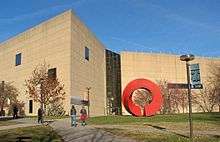 | |

| |
| Established | 1941 |
|---|---|
| Location | 1133 E 7th St, Indiana University, Bloomington, Indiana |
| Coordinates | 39.169135°N 86.519814°W |
| Type | Art Museum |
| Website | artmuseum |
The museum is located on the Indiana University Bloomington campus at 1133 E. Seventh Street.[4] As of May 15, 2017, the museum has been closed to the public for renovations to add additional gallery and teaching spaces and visitor amenities. The museum has been reopened to the public since November 7, 2019.[5]
History
The Eskenazi Museum of Art opened in 1941 in a gallery space in Mitchell Hall under the newly appointed head of the Department of Fine Arts, Henry Radford Hope.[6] The first exhibition, Sixteen Brown County Painters, opened on November 21, 1941.[1] The catalog for the event contained a statement describing the goals of the gallery at the time:
“The purpose of the Art Center Gallery… is to bring temporary loan exhibitions to the campus so that students may have an opportunity to study and see original works of art. Examples of diverse character will be brought to this gallery in order to show the multiple aspects of art both past and present.”[1]
Establishing a permanent collection did not come to fruition until after World War II. In 1955, art collectors James and Marvelle Adams gave Indiana University a terracotta bust by Aristide Maillol, which inspired Hope to revive the goal to create a permanent collection for an art museum at Indiana University.[6] The William Lowe Bryan Memorial Fund, a fund initiated by James Adams in honor of the university's tenth president and in support for the blooming museum, financed almost all of the museum's acquisitions in the early years.[1] Hope also contributed to the museum, giving a number of important works including Pablo Picasso's The Studio.[1] In the formative years of the museum, the late 1950s, 60s, and 70s, gifts to the museum accumulated rapidly.
The museum moved into the gallery space in the newly built Fine Arts building on campus, right next to the auditorium, in 1962.[1] Encouraged by then-University Chancellor Herman B Wells, the Board of Trustees of the university started budgeting a small amount for the museum each year, with additional special allocations for the Art Museum to grow the collection.[1]
In 1968, Hope hired Thomas T. Solley as the museum's Assistant Director. Solley became Director in 1971 after Hope retired.[7] Solley, a trained architect, was perfectly suited to start the process of establishing a separate building for the art museum.[6] Wanting an architect with museum-design experience, Solley and the university gave the project to I.M. Pei and Partners in 1974.[1] Completed in 1982, the space has three galleries for permanent collections and one gallery for special exhibitions.[3] Solley grew the collection from 4,000 works to 30,000 in his years at the museum.[6]
Thomas T. Solley resigned in 1986 and Adelheid M. Gealt was appointed director the following year. Gealt served until 2015. Gealt retired from the museum at the end of June 2015, at which point David A. Brenneman became the museum's Wilma E. Kelley Director.[6]
The museum was a 2012 recipient of an Andrew J. Mellon Foundation endowment challenge grant, a $500,000 award.[4]
Collections
The three permanent galleries are the Gallery of Art of the Western World, Arts of Asia and the Ancient Western World, and the Raymond and Laura Wieglus Gallery of Arts of Africa, the South Pacific, and the Americas. In the museum's Gallery of the Art of Asia and the Ancient Western World, ancient Chinese porcelains, Japanese paintings, classical Greek, Roman, and Etruscan vases, bronzes, and mosaics are on display. The Burton Y. Berry Collection of Ancient Jewelry consists of 5,000 pieces from across the ancient world.[8]
Works by German and Austrian Expressionists August Macke, Ernst Ludwig Kirchner, Alexej von Jawlensky, Max Beckmann, and Emil Nolde, along with early modern European and American masters such as Fernand Léger, Marcel Duchamp, Georges Braque, and Kurt Schwitters, are in the museum's collection.[6] American abstract artists such as Stuart Davis, Frank Stella, and Joseph Cornell are also featured in the museum's collection.[6] The works-on-paper collection includes major works by Albrecht Dürer, Rembrandt van Rijn, and Francisco Goya. The photography collection includes the archives of Henry Holmes Smith and Art Sinsabaugh.[1]
There are also European Old Master paintings by Niccolo di Buonaccorso, Apollonio di Giovanni, Taddeo Gaddi, Vittore Crivelli, Felipe Vigarny, Gerard Terborch the Elder, Emanuel de Witte, Bernardo Strozzi, and Jean Louis Laneuville, among others. There are also 19th Century European paintings by Jean Leon Gerome, Charles Daubigny, Gustave Caillebotte ("Yerres, Rain Effect"), and Claude Monet ("Port of Argentieul") among others.
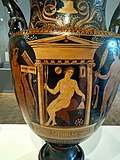 Late fourth-century BC Greek red-figure volute krater
Late fourth-century BC Greek red-figure volute krater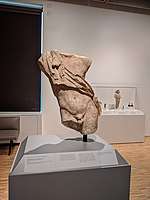 Copy of Praxiteles's Resting Satyr
Copy of Praxiteles's Resting Satyr.jpg) Ancient Greek figurine of an Amazon on horseback
Ancient Greek figurine of an Amazon on horseback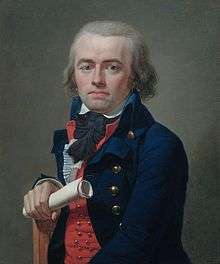 Portrait of Jean de Bry c. 1793 by Jean Louis Laneuville
Portrait of Jean de Bry c. 1793 by Jean Louis Laneuville
Education and programs
Every Saturday at 2:00 p.m. the museum offers free tours led by museum-trained docents to provide visitors with a unique experience based on close viewing and conversation.[3]
Guest lecturers, educators, graduate students, and curators lead Gallery Talks and Noon Talks on the collection and special exhibitions. Audiences gain knowledge of the historical context and significance of artworks through a process of looking and engaging with the lecturer.[3]
The One-Hour Exhibitions take place one Friday each month at 3:00 p.m. in the museum's print viewing room. These “mini exhibitions” highlight a group of works based on artist, time period, theme, or medium, and include an informal discussion led by a curator. Visitors are admitted on a first-come, first-served basis.[3]
The museum also has education programs where schools in 51 of the 90 counties in Indiana participate, allowing a reach of about 7,000 students per year. The museum partners with 55 different university academic departments to provide curriculum-based tours for students at the university.[3]
Building
The building, designed by I.M. Pei and Partners, was completed in 1982.[6] The museum was constructed as a play on angles. It is rumored to have no right angles, however this is not true. The floors meet the walls at a ninety-degree angle, and there are many square and rectangular windows in the building. The design features two concrete triangles connected by a glass-ceiling atrium.[1] The museum is 105,000 square feet: 38,361 square feet are devoted to gallery space, and 18,000 square feet comprise the atrium. The other space is used for offices, gift shop, storage, and the outdoor Sculpture Terrace.
Angles Café
Angles Café and Gift Shop, located on the second floor of the Art Museum, sells beverages and assorted pastries, as well as a vast array of jewelry, art, and gifts. There is indoor seating, as well as outdoor seating on the Sculpture Terrace for visitors.
Light Totem
The Light Totem installation at the Eskenazi Museum of Art was completed in 2007.[9] It was commissioned as a temporary installation to celebrate the 25–year anniversary of the Eskenazi Museum of Art building. Due to its popularity with the campus and community, Light Totem was approved by the Board of Trustees to become a permanent fixture outside the museum in 2010. Artist Robert Shakespeare used LEDs (light-emitting diodes) to illuminate both the 70-foot freestanding tower, and the 40-foot tube within the atrium of the museum.[10]
The Light Totem also illuminates the wall of the Art Museum with a computerized display of changing colors. Each of the lighted sections can be programmed to project any color and change color up to every tenth of a second. The entire display uses only 3,000 watts of electricity, about the amount used when a hair dryer and toaster are running simultaneously, according to the artist. Students often can be seen lying on their backs with their feet up on the wall, watching the colors change.[10]
References
- Baden, Linda J. Indiana University Art Museum: Dedication. Bloomington, IN: Museum, 1982. Print.
- Indiana University Art Museum. Indiana University Bloomington, 2004. Web. 21 May 2012. <http://www.iub.edu/~iuam/iuam_home.php>
- Indiana University, 2016. Web. 11 May 2016. <http://news.indiana.edu/releases/iu/2016/05/art-museum-gift.shtml>
- Boyum, Sarah. "IU Art Museum Receives Grant to Fund Art Courses, Academic Position." Indiana Daily Student. 16 May 2012. Web. 21 May 2012. <http://idsnews.com/news/story.aspx?id=87267 Archived 2012-07-22 at the Wayback Machine>
- "Renovation". Eskenazi Museum of Art. Retrieved 17 April 2018.
- Gealt, Adelheid M., Diane M. Pelrine, Adriana Calinescu, Judith A. Stubbs., and Jennifer A. McComas. Masterworks from the Indiana University Art Museum. Ed. Linda Baden. Bloomington: Indiana University Art Museum, 2007. Print.
- Gealt, Adelheid M., and Linda J. Baden, comps. A Transforming Vision: Thomas T. Solley (1924-2006) and the Indiana University Art Museum. Bloomington, IN: Indiana University Art Museum, 2006. Print.
- Indiana University Art Museum. Visitor's Guide. Indiana University Art Museum. Print.
- Smith, Hannah. "Museum Pole Sheds New Light." Indiana Daily Student. 22 Sept. 2011. Web. 16 May 2012. <http://idsnews.com/news/story.aspx?id=83007 Archived 2012-10-03 at the Wayback Machine>.
- U Art Museum Light Totem. Perf. Robert Shakespeare. YouTube. Google, 22 Apr. 2009. Web. 16 May 2012. <https://www.youtube.com/watch?v=CL5bqN3FQJI>.
External links
| Wikimedia Commons has media related to Indiana University Art Museum. |
